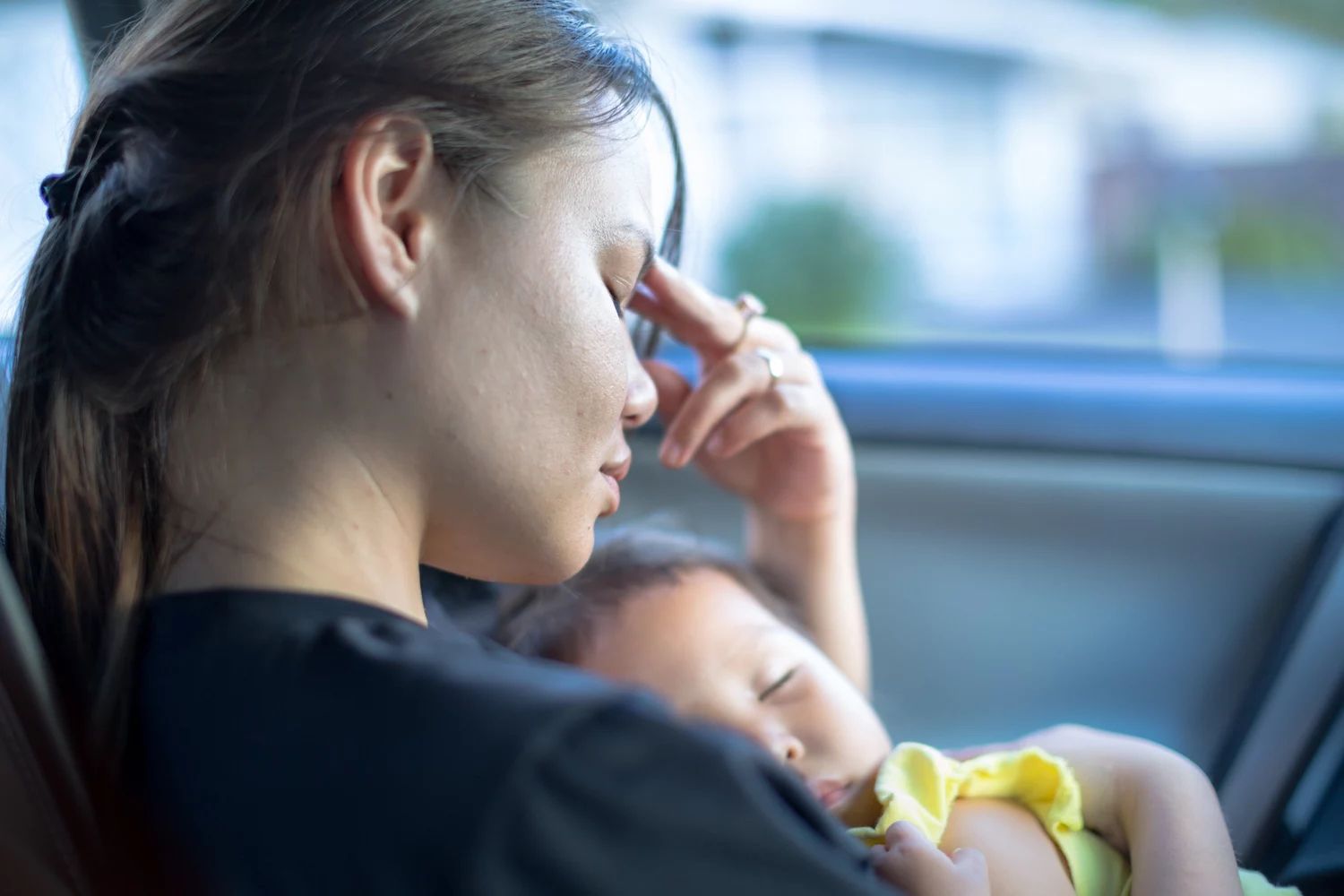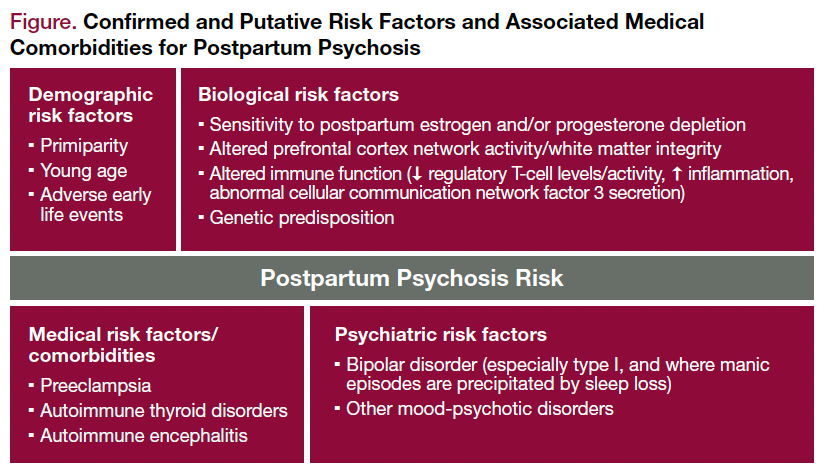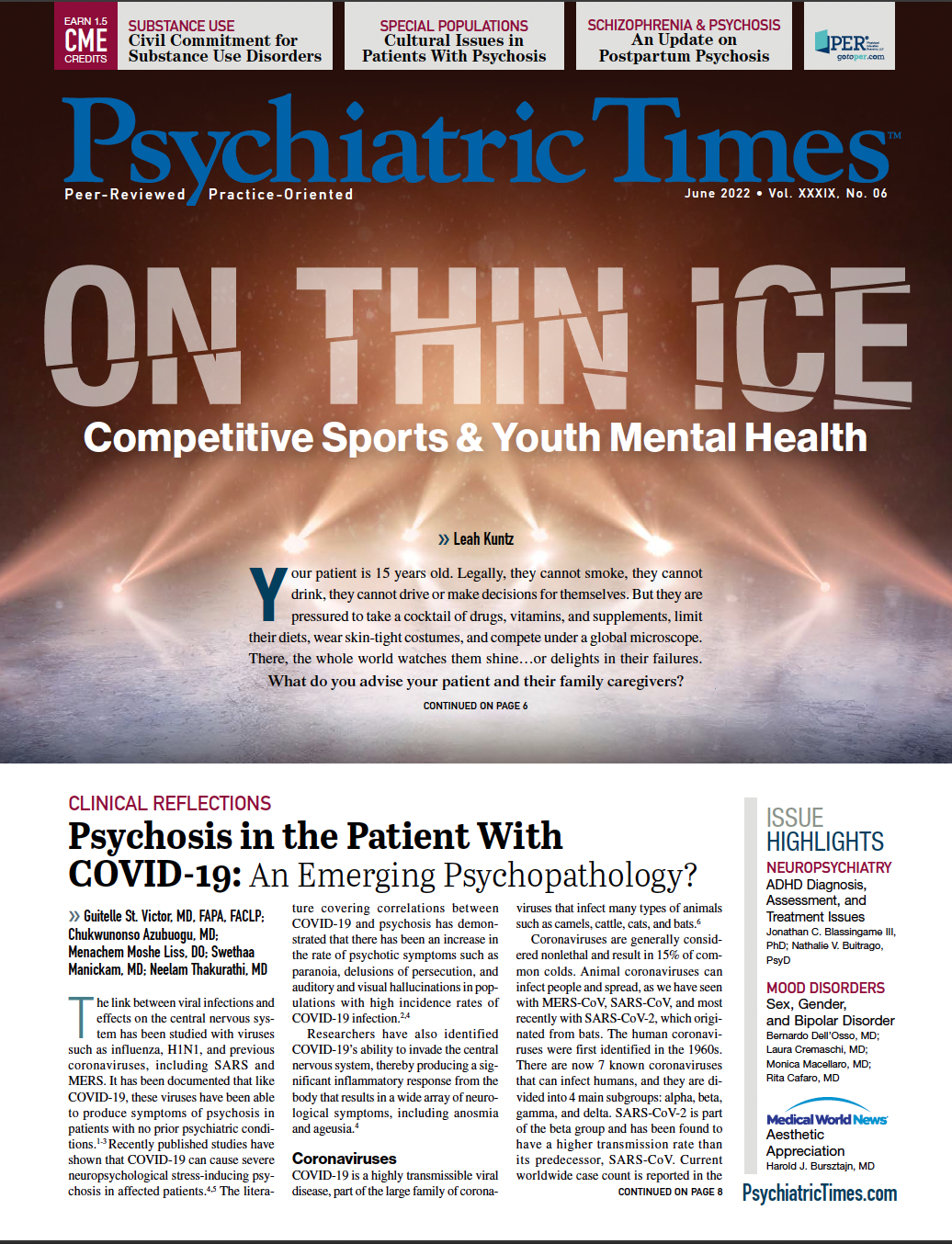Also In This Special Report
Beyond Schizophrenia: Contemporary Perspectives on Psychoses
Peter F. Buckley, MD
Cultural Issues in Caring for Clients With Psychosis
Merranda McLaughlin, MS; Amy Weisman de Mamani, PhD
Publication
Article
Psychiatric Times
Author(s):
Postpartum psychosis is experienced by 1 to 2 women every 1000 deliveries.
globalmoments_AdobeStock

SPECIAL REPORT: PSYCHOSIS PART 1
Postpartum psychosis (PP) is an umbrella term for the impairing and isolating psychotic-mood symptoms experienced by a small proportion of women (1 to 2 women every 1000 deliveries) shortly after childbirth. Despite being recognized for centuries, the condition has historically been understudied. However, over the past 10 to 15 years, stimulated by a growing interest in women’s health and increasing crosstalk among biomedical practitioners in diverse fields, we are finally starting to characterize PP more comprehensively and beginning to understand its associated risk factors and biological basis (Figure).
Figure. Confirmed and Putative Risk Factors and Associated Medical Comorbidities for Postpartum Psychosis

Individuals affected by PP typically experience hallucinations, delusions (often infant-focused), mood swings, sleep problems, and cognitive disorganization/disorientation within 2 weeks of giving birth. The condition is regarded as a psychiatric emergency and is associated with an increased risk of maternal suicide and infanticide. However, with prompt medical intervention and enduring psychiatric and psychosocial support, the acute symptoms and long-term consequences associated with PP can generally be managed effectively.
Pharmacotherapeutic options for PP include antipsychotic, mood stabilizer, or sedative administration; in more extreme cases, electroconvulsive therapy may be advisable. Pharmacotherapies can be given prophylactically in pregnant women who are at high risk of developing PP. Some of the teratogenic effects of effective drugs, such as the mood stabilizer lithium, appear to be less insidious than previously suspected, particularly if treatment regimens are appropriately titrated.1 Similarly, understandable fears about persistently impaired mother-child bonding as a consequence of PP may have been overemphasized, with a new analysis showing that bonding impairments persist in fewer than 6% of affected individuals who were affected at hospital discharge.2 Valuable qualitative research is beginning to document the experiences of women with PP and to help us understand the support mechanisms through which their recovery might be aided.3
Beyond Schizophrenia: Contemporary Perspectives on Psychoses
Peter F. Buckley, MD
Cultural Issues in Caring for Clients With Psychosis
Merranda McLaughlin, MS; Amy Weisman de Mamani, PhD
Besides a previous episode of PP, by far the largest risk factor for the condition is an existing diagnosis of bipolar disorder—particularly bipolar I disorder. Between 20% and 40% of individuals with bipolar I disorder who give birth will experience PP.4 A major challenge for the future will be deciphering the factors that distinguish women with bipolar disorder who develop PP from those who do not. The 2 groups do not appear to differ with respect to their personality traits, cognitive styles, or affective temperaments,5 but women with bipolar disorder whose manic episodes are precipitated by sleep loss may be at especially high risk.6
Current diagnostic classification systems do not recognize PP as an entity in its own right, but rather as a variant or subform of other mood-psychotic conditions. On the basis of its unique constellation of features, as well as its specific and definitive link to childbirth, some psychiatrists have called for this approach to be revised.7 Emerging data have indicated that, in individuals with bipolar disorder, the frequency and quality of symptoms in the postpartum and nonpostpartum periods may differ: In the former, there may be fewer manic symptoms, more depressive symptoms, greater perplexity and self-reproach, and less pressured speech and sociability.8
The relationship between bipolar disorder and PP risk appears remarkably strong and relatively specific, in that personal history for other mood-psychotic spectrum conditions (eg, schizophrenia, schizoaffective disorder) appears to raise an individual’s PP risk only modestly (10% to 15% of individuals with schizophrenia-like disorders develop PP).9 Additionally, in individuals with schizophrenia, PP manifests differently than it does in individuals with bipolar disorder.10 It is also noteworthy that, for around half of all cases of PP, the affected individual has no psychiatric history; the latest analysis indicates that in such women, psychotic experiences appear to be largely limited to the postpartum period, although around one-third of previously healthy women may subsequently exhibit recurrent symptoms consistent with a bipolar disorder spectrum condition.11
Numerous medical conditions may arise, or be exacerbated, in the perinatal period. These include preeclampsia (significantly elevated blood pressure and associated proteinuria typically occurring in late pregnancy) and autoimmune thyroid disorders. Preeclampsia and autoimmune thyroid disorders frequently cooccur with postpartum psychiatric symptoms, including PP. To date, little evidence is available regarding whether these conditions are causal risk factors for PP, or whether there are shared etiological factors that could predispose a woman to both PP and preeclampsia/autoimmune thyroid disorders. Although exposure to adverse life events has traditionally been more strongly associated with postpartum depression risk than with PP risk, evidence is emerging to suggest that severe childhood maltreatment, exposure to more frequent stressful life events, and elevated levels of the stress-related molecules cortisol and C-reactive protein in late pregnancy may predict PP episodes in “at-risk” women.12,13 However, given a previously reported lack of association between adverse early-life events and PP risk in individuals with bipolar disorder,14 the question of whether a link between the 2 variables truly exists remains to be answered definitively.
In terms of demographics, postpartum psychiatric symptom risk may be greater in younger mothers15 and in primiparous individuals (ie, those having their first child); however, this latter finding may be confounded by mitigating measures being put in place after a first PP episode.
New Research and Their Clinical Implications
There is strong reason to believe that PP risk is, in part, determined by biological factors: The prevalence and manifestations of the condition are similar across countries and cultures, and the condition is tightly linked to childbirth and its associated biological changes. Affected individuals and their relatives are at high risk of relapse or of first-onset PP, respectively.
Identifying and characterizing the biological features that underlie PP risk through increased collaborative endeavors and novel experimental approaches is important for 3 main reasons:
Maternal physiology changes significantly throughout pregnancy and into the postpartum period, notably with respect to immune function and circulating sex hormones. During early pregnancy, a proinflammatory state aids in successful implantation and placentation while a subsequent anti-inflammatory state protects against preterm birth and miscarriage. Predelivery, and for several months into the postpartum period, the mother’s body returns to a proinflammatory phase.16
The results of multiple recent studies have suggested that in individuals with PP, this final inflammatory phase is exaggerated—potentially, in part, as a consequence of altered activity, or number, of immunosuppressive regulatory T-cells (Tregs).16,17 Heightened immunoreactivity may partially explain links between COVID-19 infection and apparent vulnerability to psychosis across the lifespan, including in the postpartum period.18 Whether the immunological changes seen in individuals affected by PP are a cause or a consequence of the disorder remains an open question, as does the significance of these findings. Are immune system changes fundamental to PP risk, or are they merely the most observable changes, given the accessibility of relevant tissues (ie, blood)? One route to testing this question would be to test whether anti-inflammatory drug administration further alleviates symptoms and potentiates recovery in patients.
The immediate postpartum period sees precipitous drops in circulating estrogen and progesterone levels in the new mother following expulsion of the placenta. As no consistent differences have been observed in levels of these hormones between healthy mothers and mothers with psychosis following birth, it has been proposed that at-risk mothers are somehow especially biologically sensitive to estrogen and/or progesterone depletion. Through comparing brain activity at baseline and during relevant cognitive tasks, investigators at Kings College London have shown that at-risk women who develop PP exhibit altered prefrontal cortex network activity compared with at-risk women who do not develop PP.19,20 White matter integrity is altered in women with bipolar disorder and may also be perturbed in PP cases. We have proposed that defective (re)myelination processes occurring in the perinatal period may underlie PP symptoms and be related to abnormal secretion of the cellular communication network factor 3 protein by Tregs.21 Cellular communication network proteins were initially implicated in PP risk through work in a new, experimentally amenable mouse model relevant to the condition, and these proteins seem to affect numerous PP-associated neurobehavioral processes, in addition to playing a role in preeclampsia pathogenesis.22
Although immunological and neuroimaging markers associated with PP may be confounded by environmental exposures (eg, the patient’s comorbid medical conditions, demographics, or treatment), genetic factors associated with PP are stable; their impact upon disorder risk is not complicated by reverse causation issues. Early, limited linkage analyses in a sample of women with bipolar disorder and PP pointed to 2 candidate loci on chromosomes 16p13 and 8q24, the latter overlapping the cellular communication network factor 3 gene. Single-gene association studies examining candidates involved in stress, hormonal signaling, and serotonergic pathways have largely proved unreliable. Currently, collaborative efforts are underway to recruit and phenotype a sufficiently sized patient cohort to undertake a genome-wide association analysis in PP and to identify robust risk polymorphisms.
Although meaningful genome-wide analyses are not yet feasible, an insightful new study has used a genetics-based approach to provide evidence that first-onset PP may be biologically dissociable from bipolar disorder and therefore may represent a separate nosological entity within the bipolar disorder spectrum.23 Briefly, the researchers calculated polygenic risk scores for schizophrenia, depression, and bipolar disorder across 3 cohorts: healthy individuals, individuals diagnosed with bipolar disorder, and individuals diagnosed with first-onset PP. Interestingly, while bipolar disorder and schizophrenia polygenic risk scores completely or substantially overlapped between individuals with bipolar disorder and PP, depression polygenic risk scores were clearly higher in individuals with bipolar disorder than in individuals with PP.
Future Work
In the future, testing clinical samples that are larger and better defined should allow us to more robustly identify sleep-related, cognitive, neuroimaging, and peripheral biological measures (eg, immune system–related molecules) that distinguish women who develop PP both from healthy controls and from at-risk women who do not develop PP. These measures could then be tested alone, or in combination, as predictive biomarkers. Genome-wide association analysis may help identify candidate risk genes/pathways and clarify the extent of genetic overlap with related conditions; these include other mood-psychosis spectrum disorders, other postpartum psychiatric conditions, (auto)immune disorders, and preeclampsia. Genetic epidemiology techniques, such as Mendelian randomization, may subsequently be used to highlight causal pathways and to predict rational points for intervention.
The observation that children exposed to mothers with postpartum mood disorders (including psychosis) are more likely to develop attention-deficit/ hyperactivity disorder24 indicates that further investigation into mechanisms mediating this link, including the possibility of common genetic risk factors shared between PP and neurodevelopmental disorders, may be warranted. Finally, laboratory-based approaches similar to those used to understand the neurobiology of other rare conditions may be employed. For example, the cellular/molecular phenotypes underlying PP may be examined through combined assessment of patient stem cell-derived brain cell cultures or organoids (“mini-brains”) and animal models. Such work should help reveal the biology most proximal to the behavioral and cognitive disturbances in PP and highlight amenable therapeutic targets.
Ms Shepherd is a PhD candidate in the School of Medicine at Cardiff University, Cardiff, Wales. This work was supported in part by grant MR/N0137941/1 for the GW4 BIOMED MRC DTP, awarded to the Universities of Bath, Bristol, Cardiff, and Exeter from the Medical Research Council (MRC)/UK Research and Innovation. Dr Davies is a senior lecturer in the schools of medicine and psychology at Cardiff University, Cardiff, Wales.
The authors wish to thank Arianna di Florio, MD, PhD, for her comments on a draft of this article.
References
1. Fornaro M, Maritan E, Ferranti R, et al. Lithium exposure during pregnancy and the postpartum period: a systematic review and meta-analysis of safety and efficacy outcomes. Am J Psychiatry. 2020;177(1):76-92.
2. Gilden J, Molenaar NM, Smit AK, et al. Mother-to-infant bonding in women with postpartum psychosis and severe postpartum depression: a clinical cohort study. J Clin Med. 2020;9(7):2291.
3. Forde R, Peters S, Wittkowski A. Recovery from postpartum psychosis: a systematic review and metasynthesis of women’s and families’ experiences. Arch Womens Ment Health. 2020;23(5):597-612.
4. Perry A, Gordon-Smith K, Di Florio A, et al. Mood episodes in pregnancy and risk of postpartum recurrence in bipolar disorder: the Bipolar Disorder Research Network Pregnancy Study. J Affect Disord. 2021;294:714-722.
5. Perry A, Gordon-Smith K, Webb I, et al. Postpartum psychosis in bipolar disorder: no evidence of association with personality traits, cognitive style or affective temperaments. BMC Psychiatry. 2019;19(1):395.
6. Lewis KJS, Di Florio A, Forty L, et al. Mania triggered by sleep loss and risk of postpartum psychosis in women with bipolar disorder. J Affect Disord. 2018;225:624-629.
7. Spinelli M. Postpartum psychosis: a diagnosis for the DSMV. Arch Womens Ment Health. 2021;24(5):817-822.
8. Gordon-Smith K, Perry A, Di Florio A, et al. Symptom profile of postpartum and non-postpartum manic episodes in bipolar I disorder: a within-subjects study. Psychiatry Res. 2020;284:112748.
9. Munk-Olsen T, Munk Laursen T, Mendelson T, et al. Risks and predictors of readmission for a mental disorder during the postpartum period. Arch Gen Psychiatry. 2009;66(2):189-195.
10. Jones I, Chandra PS, Dazzan P, Howard LM. Bipolar disorder, affective psychosis, and schizophrenia in pregnancy and the post-partum period. Lancet. 2014;384(9956):1789-1799.
11. Rommel AS, Molenaar NM, Gilden J, et al. Long-term outcome of postpartum psychosis: a prospective clinical cohort study in 106 women. Int J Bipolar Disord. 2021;9(1):31.
12. Hazelgrove K, Biaggi A, Waites F, et al. Risk factors for postpartum relapse in women at risk of postpartum psychosis: the role of psychosocial stress and the biological stress system. Psychoneuroendocrinology. 2021;128:105218.
13. Aas M, Vecchio C, Pauls A, et al. Biological stress response in women at risk of postpartum psychosis: the role of life events and inflammation. Psychoneuroendocrinology. 2020;113:104558.
14. Perry A, Gordon-Smith K, Di Florio A, et al. Adverse childhood life events and postpartum psychosis in bipolar disorder. J Affect Disord. 2016;205:69-72.
15. Swift ER, Pierce M, Hope H, et al. Young women are the most vulnerable to postpartum mental illness: a retrospective cohort study in UK primary care. J Affect Disord. 2020;277:218-224.
16. Hazelgrove K. The role of the immune system in postpartum psychosis. Brain Behav Immun Health. 2021;18:100359.
17. Dye C, Lenz KM, Leuner B. Immune system alterations and postpartum mental illness: evidence from basic and clinical research. Front Glob Womens Health. 2021;2:758748.
18. Bider EN, Coker JL. Postpartum psychosis and SARS-CoV-2 infection: is there a correlation? Arch Womens Ment Health. 2021;24(6):1051-1054.
19. Sambataro F, Cattarinussi G, Lawrence A, et al. Altered dynamics of the prefrontal networks are associated with the risk for postpartum psychosis: a functional magnetic resonance imaging study. Transl Psychiatry. 2021;11(1):238.
20. Kowalczyk OS, Pauls AM, Fusté M, et al. Neurocognitive correlates of working memory and emotional processing in postpartum psychosis: an fMRI study. Psychol Med. 2021;51(10):1724-1732.
21. Dazzan P, Fusté M, Davies W. Do defective immune system-mediated myelination processes increase postpartum psychosis risk? Trends Mol Med. 2018;24(11):942-949.
22. Davies W. An analysis of cellular communication network factor proteins as candidate mediators of postpartum psychosis risk. Front Psychiatry. 2019;10:876.
23. Di Florio A, Yang JMK, Crawford K, et al. Post-partum psychosis and its association with bipolar disorder in the UK: a case-control study using polygenic risk scores. Lancet Psychiatry. 2021;8(12):1045-1052.
24. Chen M-H, Pan T-L, Bai Y-M, et al. Postpartum depression and psychosis and subsequent severe mental illnesses in mothers and neurodevelopmental disorders in children: a nationwide study. J Clin Psychiatry. 2021;82(4):20m13735. ❒
